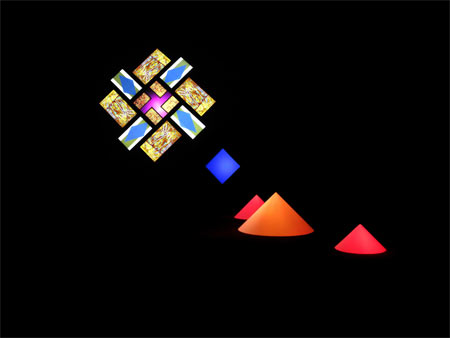
After two years of heady negotiation, a mesmerizing, mind-boggling, multimedia installation titled "77 Million Paintings" is on view thanks to the determined perseverance of University Art Museum Director, Christopher Scoates. The work of artist/musician Brian Peter George St. John le Baptiste de la Salle Eno--better known as just Brian Eno—is an innovative, 12-monitor exhibit which can now be experienced in its exclusive American engagement. In preparation for such a ground-breaking exhibition, the entire museum has been reformulated. While Eno's Ambient Music wafts through the central gallery, his one-of-a-kind computer-generated images (each framed in black) are installed on walls painted blood red.
The main attraction, however, is a side area that has been converted into a hushed, meditative theater where visitors can recline on comfortable couches and be swept away by the encounter. Since black carpets and dark walls block out all external light, six strategically located fixtures guide viewers to their seats. Created from conical piles of crushed Vermiculite, they are illuminated by an overhead LED system that slowly changes colors from red, blue, green, and yellow.
Eno's soft, inimitable sound permeates the air while a large, ever-changing image appears on the wall. Resembling a radiant stained-glass window, it is produced by three computers generating 400 images each, and one central computer overlaying 60 images. The music is so meditative and the design changes are so elusive, that it is hard to notice them at first. But slowly, surely, almost imperceptibly, the patterns mutate into an endless series of visual configurations that become hypnotic, even spiritual.
Eno calls this work "Generative Art." Using his sophisticated computer software and audio boom boxes, he set up a process that--once in motion--creates patterns and designs all on its own. The title comes from an early estimation of how many bright, glowing, commanding combinations there might be. Since none of them are ever repeated, Eno’s 77 million reference may well be a low estimate.
Eno's name is synonymous with New Wave and Ambient Music. With its focus on light and visual imagery, this installation returns full circle to where his career began many years ago. After graduating as an artist from Winchester School of Art in England, Eno began experimenting with television and manipulated light. Soon he instead became internationally known for his musical collaboration with U2, Talking Heads, David Bowie and Roxy Music.
Out of that melding of sound and vision, came explorations into "synesthesia"--the phenomena of seeing sound and hearing pictures. Today, however, the tools some artists use to create music and art have vastly changed from what they were previously. Not long ago, if you wanted to be a musician, you learned to pluck a guitar or play the piano; if you wanted to be an artist you learned how to draw and paint. But in our rapidly changed digital age ( with the help of advanced Adobe software), musicians and artists alike often use the same tools.
According to Eno, "It isn't essential to master a craft any more if your computer can do it for you." He concedes that it's nice to learn those disciplines if you choose to do so; but if your computer can do them for you, then your job as an artist is to design what your computer should do.
As for his “77 Million Paintings,” "They live an independent life of their own," says Eno. "I watch them every day, and they still surprise me."
Published courtesy of ArtScene ©2009
